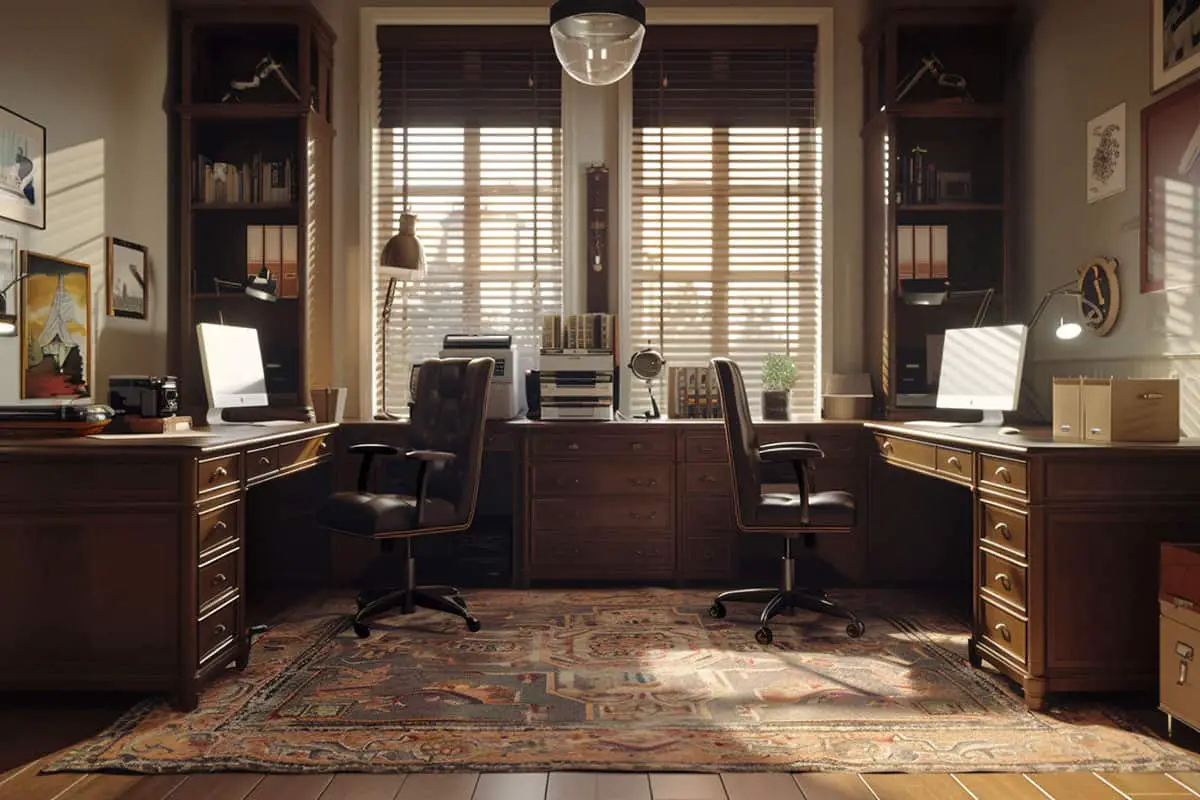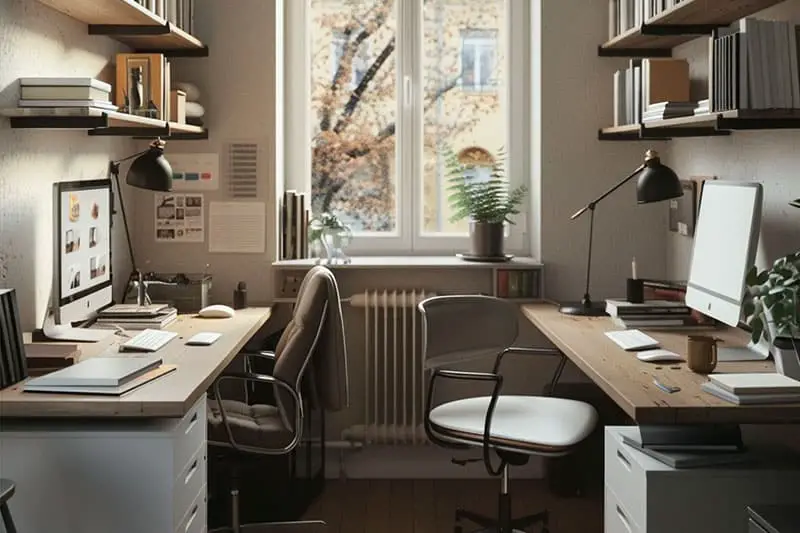This page may contain affiliate links. If you click and buy, we might get a small commission at no cost to you.
Maximizing space in a home office becomes crucial when sharing it with someone else. With two people working in the same area, it’s essential to create an environment that is both functional and comfortable. Proper space management helps prevent clutter, ensures both individuals have enough room to work effectively, and fosters a harmonious workspace.
Our home office (not pictured) is just over 100 sqft, which is smaller than your average bedroom that comes in at around 128 sqft. We are able to make it work by using some of the below tips and we don’t really make many sacrifices. We each have 3 monitors on our full-sized desks, each have our own bookshelf, etc.
Enjoy these tips and thanks for reading!
1. Measure Desk Space Size Precisely
The desks will likely be the largest pieces of furniture in your home office, making their size and placement critical. Measure the available area meticulously to ensure the desks fit comfortably without overcrowding.
Properly fitting desks help plan the rest of the office layout, allowing other furniture and storage solutions to revolve around them. Selecting desks with built-in storage can also minimize the need for additional units, optimizing movement space.
Just because you can fit large desks doesn’t mean you have to. If you have the room you may want to go with more minimalist writings desks rather than large style executive desks.
2. Find the Best Layout
Experiment with different configurations to find the most efficient arrangement. Consider placing desks back-to-back, side-by-side, or in an L-shape to optimize the available space.
Back-to-back can maintain individual work zones, side-by-side facilitates communication, and L-shaped maximizes corner space. Choose a layout that provides enough room for each person to work comfortably and efficiently.
We went with the desks side to side up against the longest wall in the room, with a filing cabinet and printer between. There was just enough room for this layout with a little to spare and I think it worked best for us.
3. Utilize Vertical Space
Maximize vertical space with wall-mounted shelves and tall storage units or narrow bookshelves to keep essentials within reach without occupying much if any floor space.
Install shelves above desks or along empty walls to store books, office supplies, and decorative items, freeing up desk and floor space. Pegboards and wall organizers can hold smaller items, keeping your workspace organized and clutter-free.
4. Squeeze in a Bookshelf (or Two)
Incorporate a slim or corner bookshelf to add extra storage without compromising space. Look for narrow or vertical bookshelves that fit into tight spaces or corners, providing ample storage for books, files, and decorative items.
A strategically placed bookshelf can also help divide the workspace, creating a sense of separation between the two individuals. After your desks are situated and you know the extra space you have to work with, take measurements and see what you can find that will help you maximize space.
5. Personalize Your Space
Decorate your half of the office with pictures, artwork, and personal items to create a sense of ownership and comfort. This enhances the functionality of the office and adds a touch of personality. It gives the feeling of being two offices even if it’s really just one.
Use decorative baskets or boxes on shelves to store smaller items, keeping the office neat and organized while making the space feel more like your own. Find some cheap wall art on Etsy or Amazon, there’s so many options.
6. Share Essential Office Items
Avoid redundancy by sharing items like filing cabinets, printers, and office supplies. This not only saves space but also fosters a collaborative environment.
By sharing these essential items, you can allocate more space for individual needs and reduce the clutter that comes with duplicate equipment. It’s nice to have your own things in every situation, but we’re sharing an office and some concessions must be made.

7. Use Dual-Purpose Furniture
Consider furniture that serves multiple functions, such as a desk with built-in storage or a bench with hidden compartments. This approach maximizes space and reduces the need for additional furniture. Dual-purpose pieces help keep the office organized and free up space for other essentials.
8. Keep Cables Organized
Use cable management solutions like clips, trays, and cord covers to keep wires tidy. Organized cables prevent clutter and make the workspace safer and more efficient. By keeping cables out of the way, you maintain a clean and professional appearance in your home office. This is one thing that can be easily maintained by a few cable management items like below, and never thought about again.
9. Opt for Minimalist Decor
Keep decorations simple and minimal to avoid a crowded and chaotic appearance. Choose a few meaningful items that add personality without overwhelming the space. Minimalist decor helps create a calm and focused work environment, which is essential in a shared office.
10. Use Portable Storage Solutions
Rolling carts or mobile drawers can provide additional storage that can be moved as needed. These portable solutions are versatile and convenient, allowing you to adapt your workspace to different tasks. They also help keep the office flexible and dynamic, accommodating the needs of both individuals.
11. Implement Good Lighting
Ensure both workstations are well-lit with proper task lighting to reduce eye strain and improve productivity. Use adjustable desk lamps or overhead lighting to create a bright and inviting workspace. Good lighting can make a small space feel larger and more open.
12. Designate Zones
Clearly define each person’s workspace to minimize overlap and ensure both individuals have their own dedicated areas. This can be achieved with rugs, dividers, or even different wall colors. Designating zones helps maintain personal space and reduces distractions.
13. Keep It Clean and Tidy
Regularly declutter and clean the office to maintain an organized and pleasant environment. Encourage both people to keep their areas tidy and use storage solutions to manage paperwork and supplies.
A clean office promotes efficiency and reduces stress. Clutter can also make a space seem much smaller than it actually is, perception is everything.



